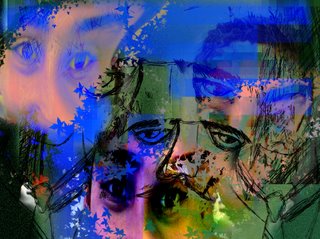"DIGITAL ME" INFORMATION COMMUNICATION LEARNING TECHNOLOGIES

"DIGITAL ME"
INFORMATION COMMUNICATION LEARNING TECHNOLOGIES
Recently I attended a professional development seminar aimed at extending teaching practices in the area of visual arts.
Afternoon workshop choices were fierce and splendid. Dynamic Drawing saw the crowded room full to capacity. Curatorship courted the refined and regal. Digital Art Making was interestingly approached by a diverse demographic, from the cynics to the critics, the convertees and the devotees. There I was - the novice participant. The facilitator, Vince Papa , is both a generous and intelligent man. He wanted his audience to walk away with enough confidence in the material he shared to be able to implement the lesson the following day. Meanwhile, back at classroom city, I was mid-way through a unit on Renaissance portraiture with year nine. Upon my return I was able to complete the lesson with a renewed focus on what I would do differently next time.I will definitely implement a unit on digital portriature. I found Vince's lesson plan enabled me to quickly master the new technologies I would be working with throughout this lesson. I have had to change a few details to suit our school's curriculum, but otherwise found his programme excellent. I would like to share with you a sample lesson programme, below, which gives you an idea of how students knowledge ( and teachers!) could grow and be applied in this area of study.
Sallyd
"THE DIGITAL ME" - YEAR 7 DURATION: 8-10 WKS UNIT DESCRIPTION: Digitally enhanced and manipulated media saturates the visual environment of contemporary society. As consumers of contemporary culture, reading and understanding computer generated imagery becomes a necessity. In this unit of work, students are introduced to the computer as a creative tool. Students will utilise software packages including Adobe Photoshop and Morph in the production of a series digital self portraits and a morphing animation. Students will also be introduced to the concept of the Frames and the Conceptual Framework in their critical and historical studies. Artist such as Yasumasa Morimura and Rea will be investigated. Examples of critical and historical writings on these artists will also be looked at. CO-CURRICULAR CONTENT KEY COMPETENCIES COLLECT ANALYSE AND ORGANISE INFORMATION INFORMATION AND COMMUNICATION TECHNOLOGIES (I.C.T): Students will learn how to use computers, image acquisition equipment (such as digital cameras and scanners) and digital imaging software (Adobe Photoshop) to manipulate imagery. WORK, EMPLOYMENT AND ENTERPRISE (W.E): USING TECHNOLOGY ABORIGINAL AND INDIGENOUS (AI): Examples of contemporary Aboriginal artworks together with the opinions and views voiced by the artists will be will be explored. CIVICS AND CITIZENSHIP: WORKING IN GROUPS DIFFERENCE AND DIVERSITY (DD): ENVIRONMENT: PLANNING AND ORGANISING ACTIVITIES USING MATHEMATICAL IDEAS GENDER (G): NUMERACY: Students will develop numeracy skills through the calculation of image sizes, dimensions and resolutions. PROBLEM SOLVING MULTICULTURAL (M): LITERACY: COMMUNICATING IDEAS

YEAR 7 VISUAL ARTS
[The digital me]
2006
Name: _____________________________
Class: ________________________________________________
Teacher: _______________________
1. Course Structure and Assessments
2. Introduction
3. Remembered Self Portrait
4. Vocabulary
5. The Frames
6. Yasumasa Morimura
6. The Conceptual Framework
7. Art Making Task
8. The Photoshop Interface
9. Guides to Scanning. Photoshop Step-by-Step
10. The Internet Research
View Year 7 Programme
Reference:
Originally compiled by Vince Papa


0 Comments:
Post a Comment
<< Home